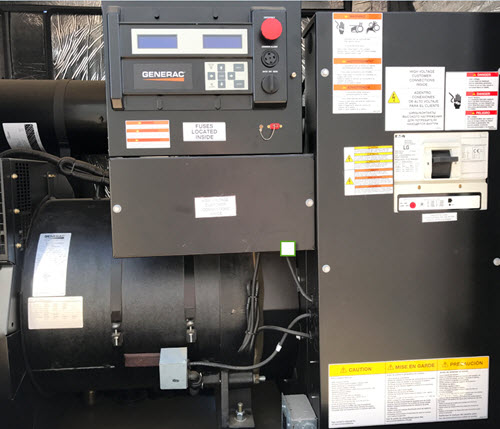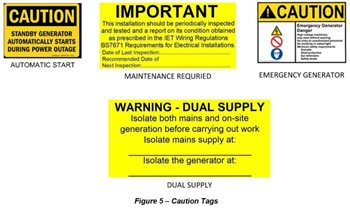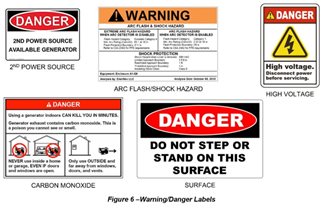Types of Labels
All generator set manufacturers are required to install safety labels in sensitive areas. In addition, information labels are placed on the engine, generator end and enclosure. Generator set labels can be separated into the following groups:
- Data Tags – Includes engine data tag and generator tag. These tags provide specifications on the engine and generator. This data is needed when troubleshooting the generator set and purchasing parts.
- Caution Labels – Caution labels are generally yellow in color. When caution labels are not followed, equipment damage can occur. Many times, caution labels interface with danger or warning labels.
- Warning/Danger Labels – Warning or Danger labels are generally red in color. If instructions on labels are not followed, equipment damage and personal injury and death can result.
Each manufacturer designs and places their labels in appropriate locations to aid in operation, troubleshooting and maintenance. Following these labels helps insure a long and dependable life of your generator set. This article will separate each type of label and provide a short definition of the contents. If questions arise on your unit always consult with the manufacturer of your unit or the skilled folks at Generator Source.
Data Tags
Generator sets are divided into two basic systems:
- Engine – Provides information on the engine. Each manufacturer differs to information supplied.
- Power Generation – Provides information on the generator to include connection information.
Engine Data Tags
When the engine manufacturer completes building and testing of an engine a data tag is attached to the engine. These tags are commonly called motor nameplates. This namepate information identifies the engine and supplies information that allows a technician to select the appropriate technical manual to maintain and troubleshoot the engine. Cummins and Caterpillar engine data tags are included in this article as examples.
Cummins Engine Tags
Data tags and nameplates are secured to the engine in an easy to view location. If the tag is missing on your engine or it cannot be found contact Cummins Customer Assistance at
Cummins Customer Assistance.
.jpg.aspx?width=575&height=241)
The engine data tag
(Figure 1) is divided into the following sections:
- Manufacturer Identification – Supplies Company headquarters location and contact information.
- Engine Identifier – The engine is a QSK60 Industrial series engine.
- Engine Specifications – Separated into the following areas:
- 2250 Brake Horsepower (BHP) and converts to (1678 kW) at 1800 RPM. BHP is the available power of engine assed by measuring the force needed to brake the engine.
- 7258 lb-ft of torque. This can be defined as the twisting turning force that is required to move one pound the distance of one foot around an axis at a radius of one foot (How twisting force of an engine is measured).
- Configuration number supplies internal information on how the engine was assembled.
- Control Parts List (CPL) is internal reference number for the replacement parts of the engine.
- Revision – Date of the software and engine electronics associated with the engine.
- Engine Displacement and Aspiration – Separated into the following areas:
- Displacement 3.661 in3 (60 L) – Engine displacement is the volume all cylinders can hold in combination.
- Aspiration – is the method air is supplied to the engine. This engine utilizes a 2-stage turbocharger system. The intake air system is both intercooled and aftercooled. Two stage turbocharger systems consist of a low-pressure turbocharger supplying a high pressure turbocharger.
- Fuel and Emissions – Separated into the following areas:
- Compression Ratio 14.5:1 – Compression ratio is defined as the maximum to minimum volume in the cylinder in an internal combustion engine.
- Fuel System Cummins MCRS – Modular Common Rail System is the newest most efficient high-pressure fuel system.
- Emission Certification – Certified to EPA Tier 2 emission level
Caterpillar Engine Tags
.jpg.aspx?width=400&height=310)
Data tags are secured to the engine in an easy to view location. If the tag is missing on your engine or it cannot be found contact Caterpillar Maintenance and Support at
Caterpillar Maintenance and Support.
The engine data tag (Figure 2) is divided into the following sections:
- Model Number – Identifies the engine as at Caterpillar C175-20.
- Manufacturer – The engine is manufactured by Caterpillar. Various copy right and registered symbols.
- Product Identification Number – CATC1752HBXR01224. This illustrates the engine is a CAT C17520. HBXR01224 is the manufacturing portion of the number. This number is the number used when requesting service or ordering parts.
- Manufacturer Location – Supplies company headquarters and manufacturing location information.
Power Generation
When the generator manufacturer completes building and testing of the generator a data tag is attached to it. This tag supplies generator information. In addition, basic information on the engine that allows technician to select appropriate technical manual to maintain and troubleshoot the generator. Cummins/Onan and Caterpillar generator data tags are featured.
Cummins/Onan Generator Set Tags
.jpg.aspx?width=350&height=331)
Generator data tags are secured to the generator in an easy to view location. These tags are commonly called electric motor nameplates. If the nameplate or tag is missing on your generator or it cannot be found contact Cummins Customer Assistance at
Cummins Customer Assistance.
The generator data tag (Figure 3) is divided into the following sections:
- Generator operating information as follows:
- 24 VDC Battery bank required for generator set application.
- Generator rotating speed is 1800 rpm.
- Generator rated at Nominal as standby power source.
- Generator Specifications as follow:
- Frequency is 60 HZ.
- Rated for standby operation only (many generators will show both standby and prime detail here).
- Three phase operation at 1250 kW (1562.5 KVA) with a 0.8 power factor. This is the output of the generator.
- Manufacturer Information – This includes manufacture location, generator model and serial numbers.
- Connection information – Divided into VOLTS and AMPS columns. Supplies amperage draw for various voltage connections.
- Wiring diagram number for troubleshooting and connection options.
Caterpillar Generator Set Tags
.jpg.aspx?width=450&height=380)
Generator data tags are secured to the engine in an easy to view location. If the tag is missing on your engine or it cannot be found contact Caterpillar Maintenance and Support at
Caterpillar Maintenance and Support.
The generator data tag (Figure 4) is divided into the following sections:
- Manufacturer and Description – Caterpillar Generator Set
- Generator Specification as follows:
- Engine Model is 3508 manufactured in 2002.
- 1250 KVA, 1000 kW (output power) 0.8 power factor at 60 Hz.
- Rated for standby use.
- Generator data as follows:
- 3 Phase 6 wire generator that can be wired in Delta (wye) or Parallel (series) configurations by technicians.
- Generator supplies 480 VAC with 1504 amps capability
- Require 43 VAC at 8 amps to excite the filed.
- 1800 rpm minimum required.
- Maximum operating temperature 266°F (130°C) with an ambient temperature of 104°F (40°C).
- Has class H insulation in windings and can be operated at 3280 ft (1000 m).
- Generator serial number for ordering parts.
Caution Labels

Caution labels
(Figure 5) are generally used to identify practices that will cause damage to the generator set or associated equipment. Often, they are used in preface to a warning (dual voltage supply on enclosure with warning on electrical panel). There are a great many cautions, below are some examples of the use of these tags:
- Automatic Start – This can be placed at entrances to spaces or enclosures informing of automatic start without warning or consent.
- Maintenance Required – This label is used to determine maintenance requirements and next inspection requirements. As each requirement is completed the labeled is changed.
- Emergency Generator – This would be located on the outside of an enclosure or door to a generator room.
- Dual Supply – This is an informational label that would be placed in close proximity of a warning label. Isolation information is supplied.
Warning/Danger Labels

Warning and Danger labels
(Figure 6) are both considered an industry standard labels. It is imperative to follow the information contained in the label. If the information in the label is not followed it can result in serious injury, death and equipment damage. Below are a few examples of warming tags in generator applications:
- 2nd Power Source danger label will appear at panels that have dual power source. A label listing the locations to secure the source can be included in the general area.
- Arc Flash/Shock warnings can be placed at the generator connection panel. This indicate voltage and the distance the flash can extend.
- High Voltage – Placed on all access points in the power generation system where high power connections exist.
- Carbon Monoxide – This can be placed on exhaust point at installed generators. Always on residential portable generators. Operating generator without proper exhaust can kill.
- Surface – Located on structures designed for operator protection but not designed to stand on.
>>Back to Articles & Info<<